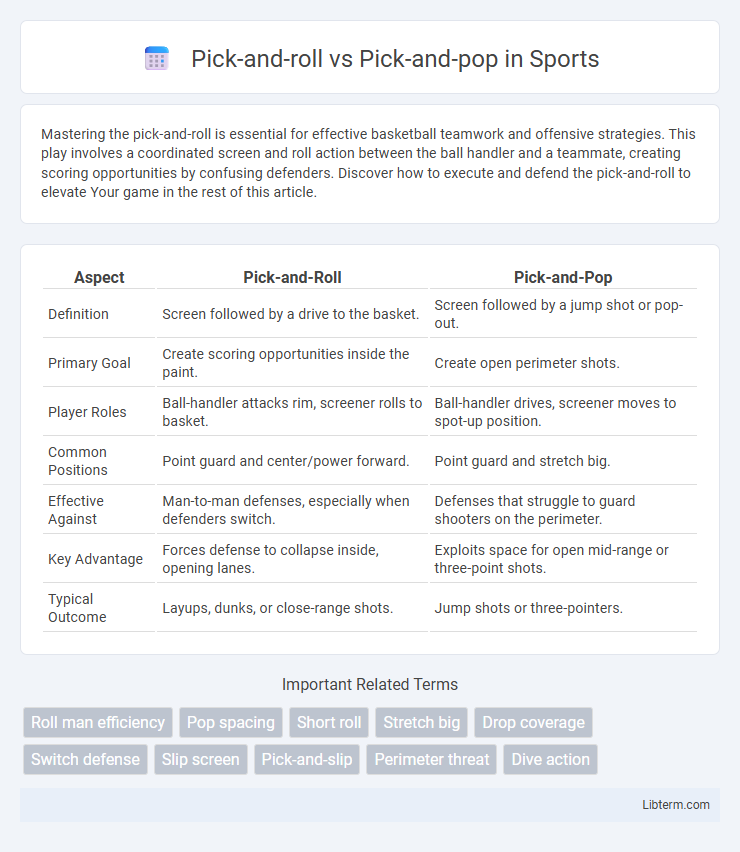Mastering the pick-and-roll is essential for effective basketball teamwork and offensive strategies. This play involves a coordinated screen and roll action between the ball handler and a teammate, creating scoring opportunities by confusing defenders. Discover how to execute and defend the pick-and-roll to elevate Your game in the rest of this article.
Table of Comparison
| Aspect | Pick-and-Roll | Pick-and-Pop |
|---|---|---|
| Definition | Screen followed by a drive to the basket. | Screen followed by a jump shot or pop-out. |
| Primary Goal | Create scoring opportunities inside the paint. | Create open perimeter shots. |
| Player Roles | Ball-handler attacks rim, screener rolls to basket. | Ball-handler drives, screener moves to spot-up position. |
| Common Positions | Point guard and center/power forward. | Point guard and stretch big. |
| Effective Against | Man-to-man defenses, especially when defenders switch. | Defenses that struggle to guard shooters on the perimeter. |
| Key Advantage | Forces defense to collapse inside, opening lanes. | Exploits space for open mid-range or three-point shots. |
| Typical Outcome | Layups, dunks, or close-range shots. | Jump shots or three-pointers. |
Introduction to Pick-and-Roll and Pick-and-Pop
Pick-and-roll and pick-and-pop are fundamental basketball offensive strategies that utilize screens to create scoring opportunities. In the pick-and-roll, a player sets a screen and then rolls toward the basket, aiming for a close-range shot or layup, often exploiting the defense's hesitation. Conversely, the pick-and-pop involves the screener stepping away from the basket to take an open jump shot, capitalizing on defenders who collapse inside.
Understanding the Fundamentals of Each Play
The pick-and-roll involves a screener setting a pick then rolling toward the basket to receive a pass, creating opportunities for close-range shots or driving lanes. The pick-and-pop features the screener stepping out to an open mid-range or three-point shot instead of rolling, emphasizing shooting over penetration. Mastering the pick-and-roll requires strong timing and decision-making for passing or finishing, while the pick-and-pop demands effective spacing and shooting accuracy.
Key Differences Between Pick-and-Roll and Pick-and-Pop
The pick-and-roll involves a screener setting a pick and then rolling toward the basket to receive a pass, aiming for a close-range scoring opportunity. In contrast, the pick-and-pop features the screener stepping back from the pick to take an open jump shot, emphasizing perimeter scoring. Key differences include the screener's movement--rolling to the rim versus popping out for a shot--and the offensive spacing and scoring options created by each tactic.
Player Roles and Skills Required
Pick-and-roll primarily requires a strong ball-handler with excellent dribbling and decision-making skills, coupled with a rolling big man who excels in finishing at the rim and setting effective screens. In contrast, pick-and-pop demands a versatile big who can shoot proficiently from mid-to-long range, creating spacing while the ball-handler penetrates or passes. Both strategies emphasize coordination, timing, and the ability to read defenses, but pick-and-roll centers on interior scoring, whereas pick-and-pop leverages outside shooting skills.
Impact on Team Offense and Spacing
The pick-and-roll enhances team offense by creating dynamic scoring opportunities through ball-handler penetration and roller finishing, forcing defenses to collapse and open lanes for shooters. In contrast, the pick-and-pop emphasizes spacing by having the screener step out for a jump shot, stretching the defense and creating multiple perimeter shooting threats. Both strategies improve offensive spacing but the pick-and-roll drives interior pressure, while pick-and-pop prioritizes perimeter shooting balance.
Defensive Strategies Against Each Play
Defensive strategies against pick-and-roll often emphasize switching or hedging to disrupt the screener-handler connection and prevent easy penetration or open shots. In contrast, defending pick-and-pop requires defenders to aggressively close out on the popping shooter while maintaining awareness of the rolling big man to avoid mismatches or uncontested baskets. Teams frequently deploy zone defenses or trap tactics to neutralize pick-and-pop threats, balancing perimeter pressure with interior protection.
NBA Examples: Teams That Excel at Each Play
The pick-and-roll is a fundamental NBA play executed by teams like the Utah Jazz, featuring Donovan Mitchell and Rudy Gobert, where the ball-handler uses a screen and then drives to the basket or passes to the rolling screener for a layup or dunk. In contrast, the pick-and-pop shines with players like Luka Doncic and Kristaps Porzingis of the Dallas Mavericks, who use the screen to create space and then pop out for open mid-range or three-point shots. Teams such as the Philadelphia 76ers, with Joel Embiid and James Harden, also leverage pick-and-roll and pick-and-pop versatility to exploit defenses and maintain offensive efficiency.
Advantages and Disadvantages of Pick-and-Roll
The pick-and-roll creates significant offensive advantages by forcing the defense into a dilemma, often resulting in mismatches and open scoring opportunities for the ball-handler or the rolling screener. However, its effectiveness can be diminished against disciplined defenses that communicate well and hedge or switch efficiently, potentially leading to turnovers or contested shots. Teams relying heavily on pick-and-roll may become predictable, allowing opponents to adjust defensively and limit scoring options.
Advantages and Disadvantages of Pick-and-Pop
Pick-and-pop leverages a screener's shooting ability by allowing them to step out for a jump shot after setting a pick, creating spacing and scoring opportunities from mid-range or beyond the arc. Its advantages include forcing defenders to defend a shooter away from the basket, opening driving lanes for the ball handler and reducing defensive congestion in the paint. However, pick-and-pop disadvantages arise when the shooter lacks reliable range or quick release, limiting its effectiveness and risking defensive rebounds against poorly timed or missed shots.
Choosing the Right Strategy: When to Use Each Play
Pick-and-roll excels in creating scoring opportunities near the basket through aggressive screens and quick ball movement, ideal when facing strong interior defenders. Pick-and-pop suits teams with proficient shooters who can space the floor and capitalize on open perimeter shots following a pick, especially effective against defensive schemes that collapse on the roller. Selecting between these plays depends on the roster's shooting ability and defensive tendencies, optimizing offensive efficiency by exploiting specific matchup advantages.
Pick-and-roll Infographic

 libterm.com
libterm.com